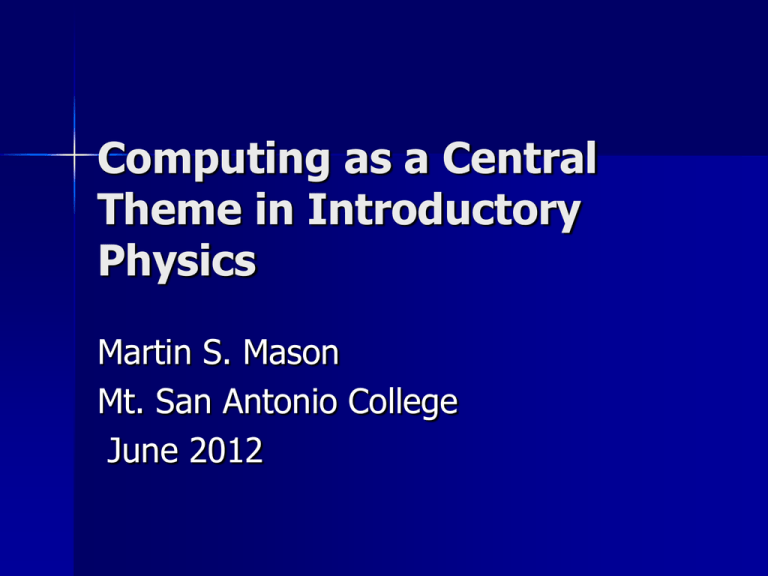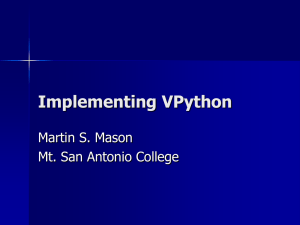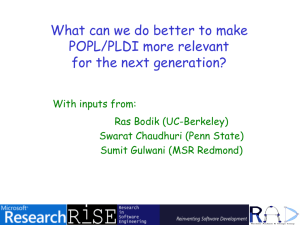Why Do Computational Modeling
advertisement

Computing as a Central Theme in Introductory Physics Martin S. Mason Mt. San Antonio College June 2012 What is computational modeling? Using the outputs of a computer system to describe or predict the behavior of a physical system. Why Computational Modeling? Tackle interesting problems that can’t be ‘solved’ analytically with freshman physics, but can be approximated. This is no right answer, just a series of more accurate approximations. A large part of what modern Scientists and Engineers actually do! Students need Computational Skills A New direction for Physics Laboratories What best describes your laboratory? A. B. C. D. E. Separate from Lecture with a different instructor / TA Separate from Lecture with the same instructor Integrated with Lecture (Studio or Workshop format) Block Schedule No Lab defined How often is lab offered per week? A. B. C. D. 4 or more times 3 times Twice Once What should we do in Laboratory? Laboratory activities must be designed so that students may acquire skill and confidence in: – Measurement of physical quantities with appropriate accuracy – Recognition of factors that could affect the reliability of their measurements – Manipulations of materials, apparatus, tools, and measuring instruments – Clear descriptions of their observations and measurements – Representation of information in appropriate verbal, pictorial, graphical, and mathematical terms – Inference and reasoning from their observations – Ability to rationally defend their conclusions and predictions – Effective and valued participation with their peers and their teacher in a cooperative intellectual enterprise – Articulate reporting of observations, conclusions, and predictions in formats ranging from – Informal discussion to a formal laboratory report – Ability to recognize those questions that can be investigated through experiment and to plan, carry out, evaluate, and report on such experiments. What is Vpython? a free, open-source, multi-platform, 3D programming environment especially suitable for use by students in introductory physics courses (including novice programmers). Written by David Scherer for Ruth Chabay and Bruce Sherwood’s Matter and Interactions course Computational Modeling in the lab What do we do? – Extend hands on experiments with models – Create visualizations that help with conceptual understanding – Develop transferable programming and visualization skills What don’t we do: – Run simulations that someone else wrote Why Do Projects? Students as Scientists Treat more detailed problems Give sense of connection between physics topics How and Why physics is useful It’s Fun! Projects Three 5 week projects. Six hours in class and 20-30 hours outside of class. Project is designed to require course material from that five week period and before. Projects change every semester. Project is presented as a formal powerpoint presentation. Types of Projects Create a computational model that predicts the behavior of a physical system. Create a computational model that investigates something that can’t be modeled physically. An open ended problem chosen by the student, Compare the behavior of a physical system and the behavior of a computational model with theoretical calculations. Example Model the behavior of a foam rocket launched from an elastic launcher. Compare the results of your model to the actual trajectory determine from video analysis. Competition. Example Create a system of three lunar orbiting communication satellites that always provide a link from the north pole of the moon to the earth. Include the gravitational effects of both the moon and earth on the satellites. Show that your system is stable for 10 years. Final Project A mass is placed on a low friction cart attached to a spring. At what amplitude will the mass on the cart begin to slip? Video of System Computational model Textbook solution makes many simplifying assumptions Outcomes: More students transition into summer REU/Research programs. Anecdotal reports are positive about the utility of projects after transfer. Difficult to measure impact on traditional assessment. Student retention was lower for first three semester after the projects were implemented, but has climbed back up. Project Grades vs. Exam Grades Project Rank Projects measure different skills then exams. Students who do well on exams do not always do well on projects and vice versa. Exam Rank 1 4 2 2 3 3 4 6 5 20 6 7 7 14 8 1 9 18 10 12 11 16 12 11 13 8 14 15 15 17 16 9 17 10 18 5 19 13 20 19









